| ID |
Date |
Author |
Type |
Category |
Subject |
|
193
|
Thu Nov 26 06:20:21 2009 |
Keerthi Jayamanna | | | Supernanogan Development |
Swiched off all the pumps and ion gauge for oven installation.
|
|
129
|
Mon Aug 17 13:58:35 2009 |
Damien Gallop | | | Supernanogan Development begins today for one week |
Supernanogan Development begins. It will be a marathon. Main goals are high-charge emittance scans and RF frequency scans. Tall order.
Meanwhile, the MWS came out as planned. Thank goodness for the quartz liner, which took most of the hit from the magnesium. IOS optics are another story. We are running with an alternate tune for Q1/Q2/Q3, as noted elsewhere. The Supernanogan, already at vacuum, pumped down nicely, as did IOS and the IM section. Basically it was a weekend of HV conditioning. Mostly as expected. We got to a solid 27kV. Plasma lit and 22Ne2+ beam tune installed and beam on FC6 for hours. I'll include a stripchart if I can find one.
Preliminary mass scan. It looks okay. Slits are wide-open. Yes, I found a 22Ne2+ FC6 stripchart too.
Next:
- Slits in: done.
- Check A/q calibration: change const22 from .04156 to 0.041777 based on 22Ne position.
- Mass scan:
|
| Attachment 1: Picture_43.png
|
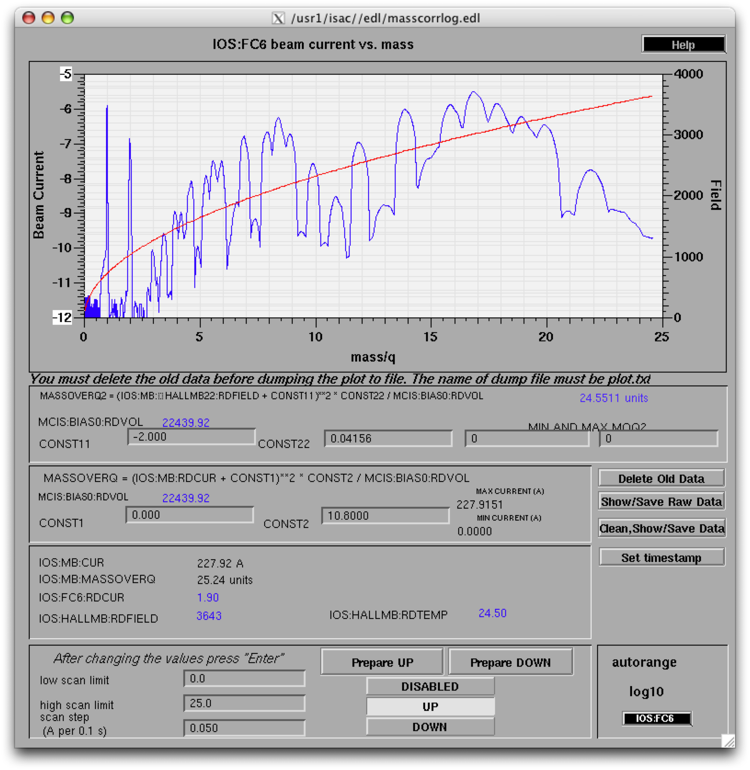 |
| Attachment 2: grab.a30699.png
|
 |
|
35
|
Tue Jun 30 09:33:00 2009 |
Damien Gallop | Routine | General | Supernanogan Development begins today for two weeks |
Supernanogan development starts today. The TACTIC run, which ended around 08:30 today, appears to have been a success. TACTIC used our beam for setup and pilot, then took 8Li from downstairs. Marco is doing some EOB checks now. We will begin at 10:00. First part of our run plan will be to compare the present 16O2+ beam with how it looked when we started, and identify what might have changed.
Proposed Run Plan for Today &ff
1. Compare present 16O2+ beam with start of TACTIC run and identify change factors.
2. RF frequency scans versus each charge state of 16O.
3. Identify frequency with largest bandwidth for each state.
4. Emittance scan for best beam of each state.
5. Compare with earlier emittance scans.
6. Select one clean beam and test whether or not RF amplitude changes best frequency.
7. Comprehensive mass scan.
|
|
418
|
Mon Aug 8 17:08:28 2011 |
Damien Gallop | | | Supernanogan MRO |
Cart removed for source servicing. Source opened and split at front seal. Ground and plasma electrodes removed. All internal areas cleaned. Source reassembled. Initial pumping in progress. Leak-up curve a little soft, but reasonable given the cleaning materials used: methanol, acetone, Simple Green. |
| Attachment 1: grab.w19243.png
|
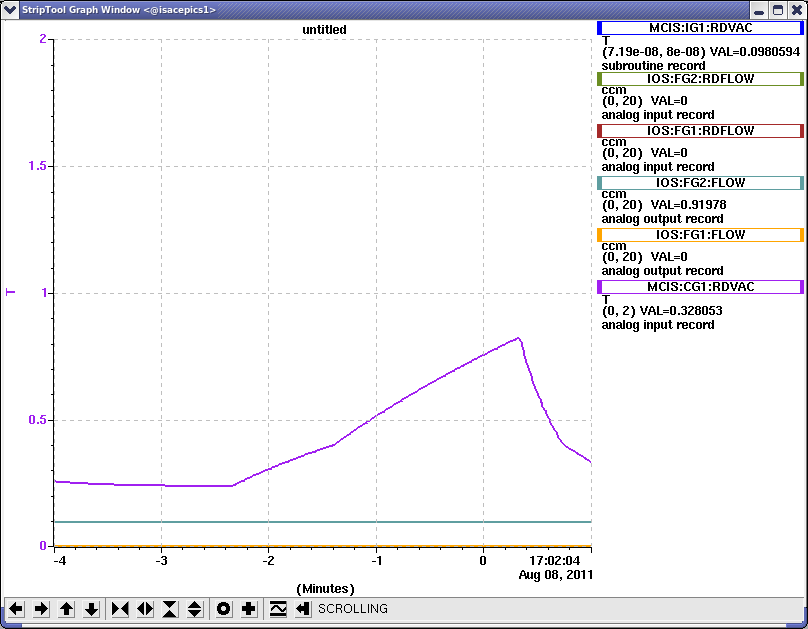 |
| Attachment 2: grab.q19378.png
|
 |
|
12
|
Tue Jun 9 20:49:32 2009 |
Damien Gallop | Routine | General | Supernanogan RF & IOS slits |
I have been testing various RF power settings for cold starts and beam stability. No surprise, the best tuner setting is approximately midway at about 58%. Different slit selections tested. Emittance scans in progress. Done. |
| Attachment 1: grab.T18854.png
|
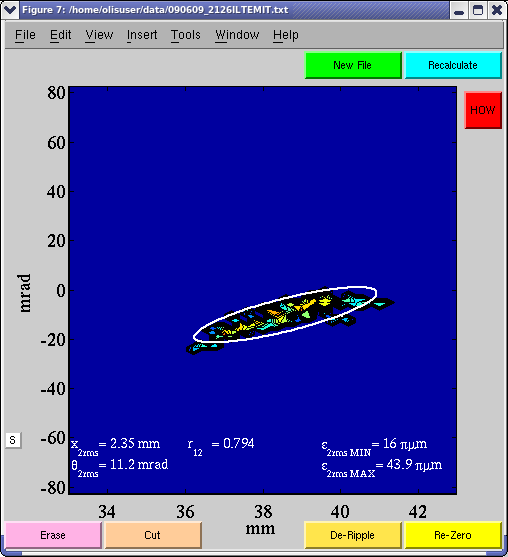 |
| Attachment 2: grab.s18900.png
|
 |
|
263
|
Fri May 7 12:29:41 2010 |
Keerthi Jayamanna | | | Supernanogan development |
Supernanogan development for 33S started. All MW and MW and MCIS power sypplies are off.
Gas for microwave source also closed from hand valve
Later... separator field stability development. Local Hall probe is online. Let it cook. |
|
266
|
Mon May 10 16:42:55 2010 |
Damien Gallop | | | Supernanogan development |
By agreement, the source came down this morning for continuing Supernanogan development. Main event: leak detecting.
Later... Robert and Tim lead leak detectors. Synopsis: A minute leak at waveguide flange on plasma chamber. We decided to seal it with a drop of vacuum sealant. Worked like a jet. Once Supernanogan beams are done for this beam schedule, we will remove the waveguide and re-machine and weld the flange. We also believe there is a minute leak at the bellows joining MCIS and IOS. TBC. |
|
267
|
Tue May 11 08:55:41 2010 |
Damien Gallop | | | Supernanogan development |
Leak checking on the Supernanogan continues today. We are preparing for an up-coming 33S run, for which we want "perfect" vacuum. We're close.
Later... MCIS backing line is now running on leak detector only. Calibration in progress... Done.
There was a short MCIS vacuum excursion at ~09:15. There were two similar ones overnight. Probable cause: sealant outgassing.
Later... MCIS leakcheck tested excellent. Our fix was good, and there were no signs of a leak after all in the bellows area. We are good to go.
Next item: IOS leakcheck if possible. At somepoint we also want to test out the solid target tube on the MCIS plasma chamber.
Later... IOS leakcheck in progress. Leak found at water feedthroughs on DB3 and touched up with same sealant as above. Sealed. Continuing down the line...
Later... We determined a small leak on the top flange of IOS:DB6, which we were able to help from outside. We also observed a significant gas loading from downstream of IOS:IV7. It is indeterminate at this time whether or not there is a specific leak. However, we also observed a fairly high pressure downstream of ILE:IV6. Closing that valve, however, had no effect at IOS.
At about 16:45, Colin requested beam for an energy check. We are doing a last leakcheck between IOS:MB and IOS:IV7 before we close it down and prepare for beam.
At 1about 17:15, MWS lit. >2enA of 22Ne2+ on FC6. |
| Attachment 1: grab.tg1846.png
|
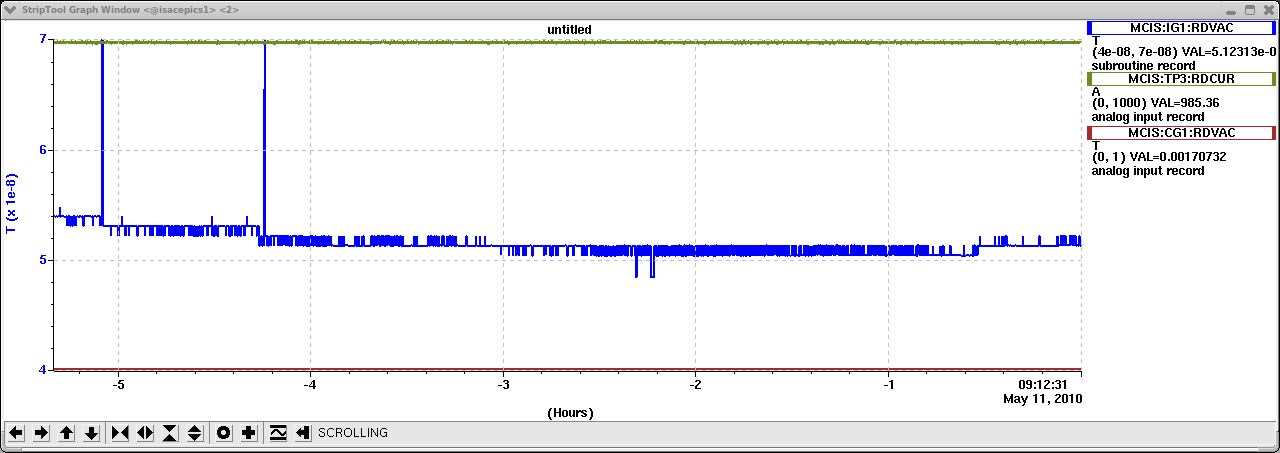 |
| Attachment 2: grab.bE1993.png
|
 |
| Attachment 3: grab.ed2041.png
|
 |
| Attachment 4: grab.or2050.png
|
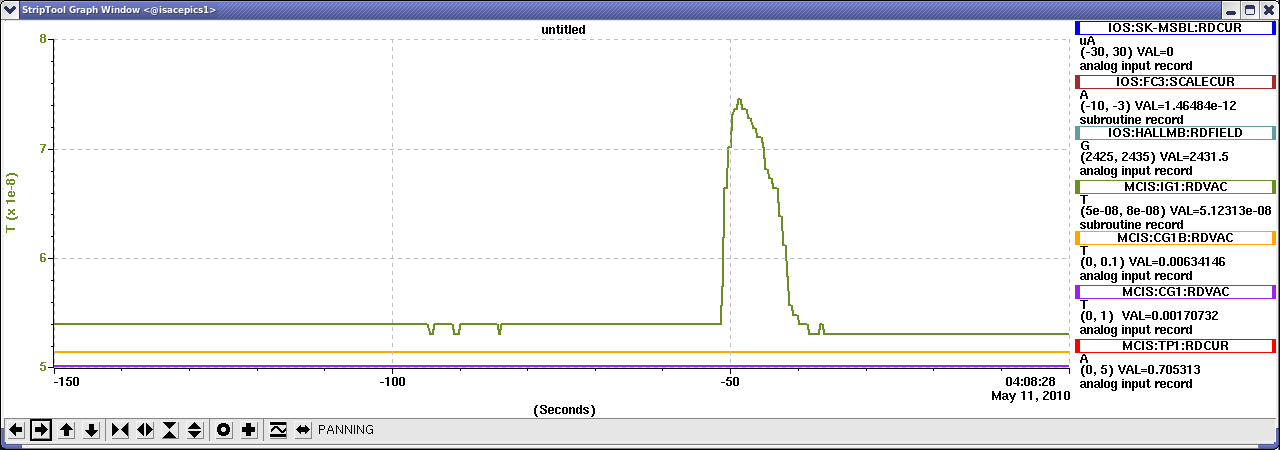 |
|
69
|
Mon Jul 13 17:41:04 2009 |
Damien Gallop | | | Supernanogan development Monday morning |
As noted, Keerthi was called to restart the source after a power bump. He continued Supernanogan development through the night (can you imagine?!?). He made some great progress. Here is a partial summary of his findings.
Actions taken: frequency scans across the entire range from 12-16GHz for each charge state of 18O.
For 18O4+, the "perfect" resonance occurred at 13.00GHz, with other resonances at 13.26, 13.54, 13.74... i.e. at about 26MHz intervals. The lowest resonance is the least noisy. However, if it trips, it is also impossible to restart it without playing with the RF. Based on Keerthi's instructions, I have written up a draft of an ION note for Operations, describing how to restart the Supernanogan source if it trips. I have asked the operators to critique the draft. The present RF state is attached below. |
| Attachment 1: Picture_20.png
|
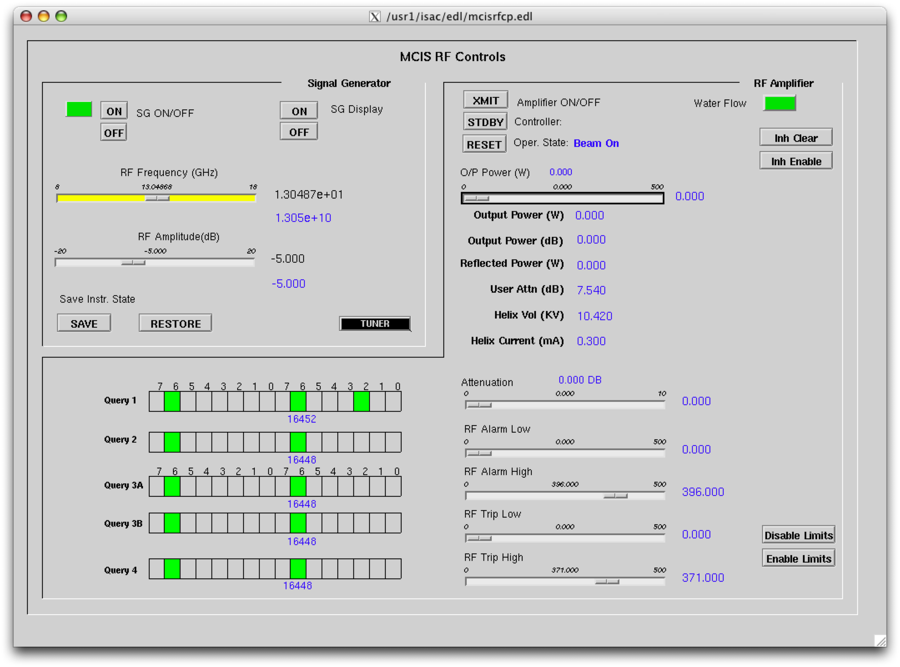 |
|
106
|
Fri Jul 17 11:10:21 2009 |
Damien Gallop | | | Supernanogan development done |
Beam switched back to 18O4+ by 11:00 as agreed. Some glitches. Here are snapshots of how it looked at handover time.
Later... Sophia prefers using all previously-saved files including ion source. Okay.
Note: For fun, Controls took away isacwserv mid-morning. The ICR did not communicate to them that I was the user... Workaround done with Keiko. |
| Attachment 1: grab.P25671.png
|
 |
| Attachment 2: grab.s25677.png
|
 |
| Attachment 3: grab.c25693.png
|
 |
| Attachment 4: grab.b25867.png
|
 |
| Attachment 5: grab.e25896.png
|
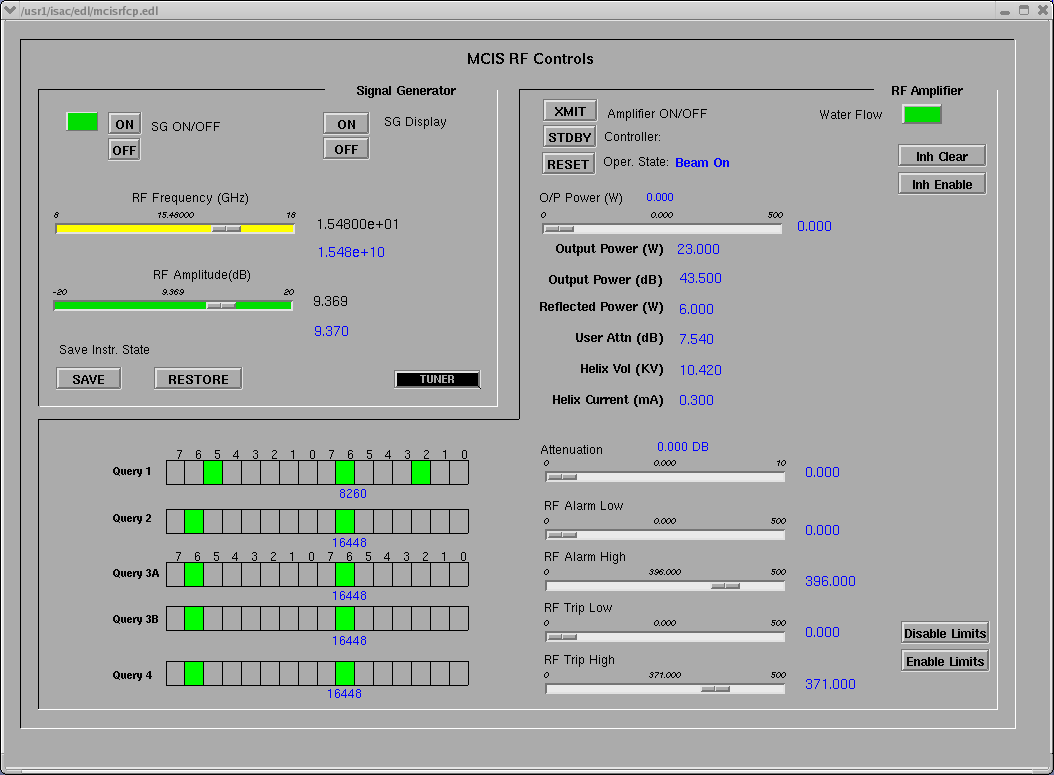 |
| Attachment 6: grab.U26048.png
|
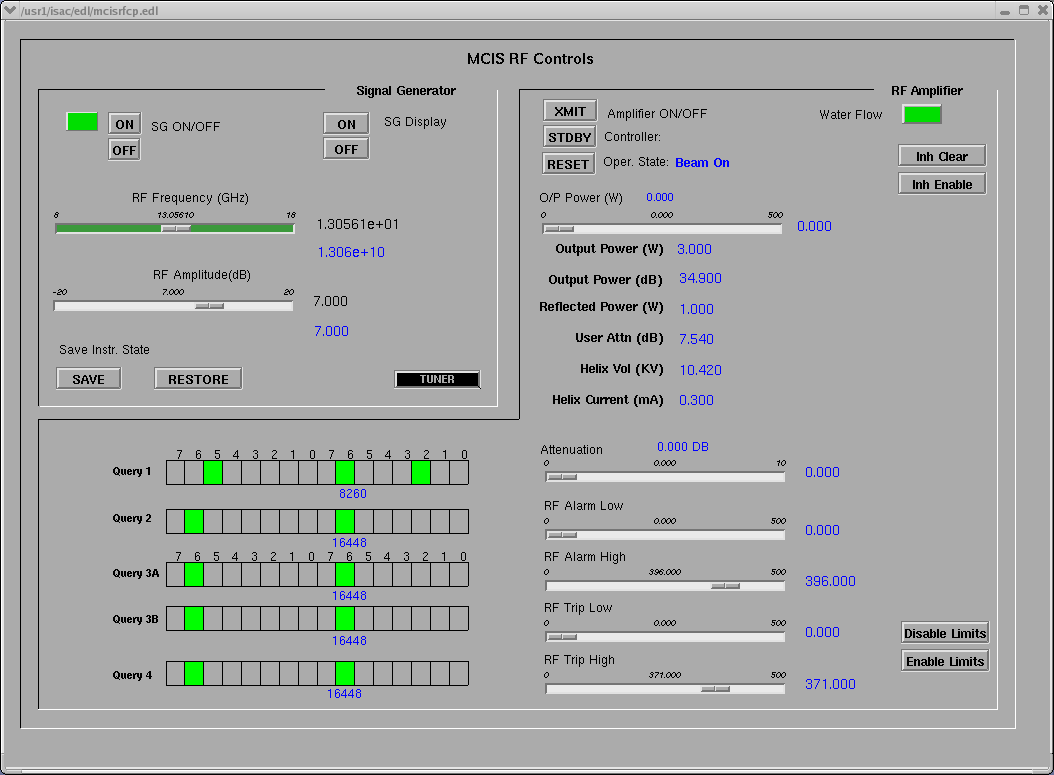 |
|
11
|
Tue Jun 9 16:53:55 2009 |
Damien Gallop | Routine | General | Supernanogan development in progress |
Keerthi started the Supernanogan source today. His primary goal was to test out Rick's theoretical tune calculations. He was ecstatic with the results. Rick's table gives a tentitive value for the Einzel lens. In fact the ideal value is at or even higher than the bias voltage. However, Keerthi experieced sparkdowns at those voltages. Rick's calculation gives a reasonable number for better than 50% transmission between MCIS:FC0 and IOS:FC3. The Enzel lens at full chat (10KV with the present power supply) gives a transmission of close to 90% with 11.5KV bias. So far, there are no sparkdowns. Keerthi suspects a resonance effect with the earlier sparkdowns. Presently we are observing beam and optics stability, with about 16nA of 17O3+ on IOS:FC6. I'll do some scans in a while. |
|
40
|
Thu Jul 2 11:58:18 2009 |
Damien Gallop | Routine | General | Supernanogan development in progress |
Happy Canada Day!
I noticed a long-term trend in beam intensity. I have every reason to believe that the source itself is rock-solid. I think it is temperature variation affecting the Philtek power suply on the separator magnet. What bothers me is that the stability program appears to not be compensating for this. I am looking into this now. Here is a plot of beam current, mag field and temperature (at AHU-1, the best I could do). There appears to be a delayed response to temperature. I have turned off our Hall probe for an hour or so to watch the response on a stripchart.
Well, there were results, but not what I expected. The beam became nearly out of control while the stability program was disabled. What's more is that the correct field came back immediately upon turning on our Hall probe again. Here are a couple of stripcharts, one snapped right after turning on the probe, and again a while later The stability program was disabled during the middle couple of hours or so. Note that the beam is oddly more stable in the short term now also. |
| Attachment 1: Picture_29.png
|
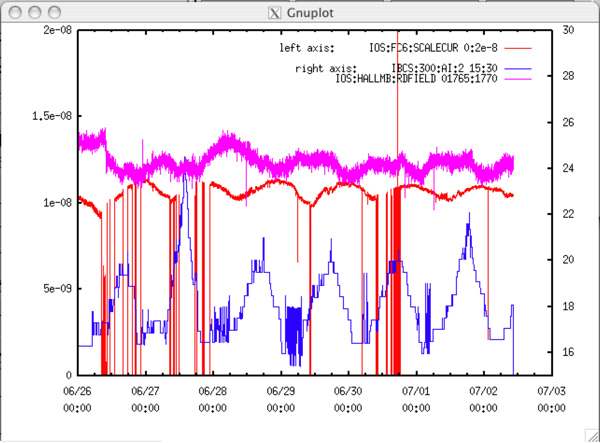 |
| Attachment 2: grab.x14914.png
|
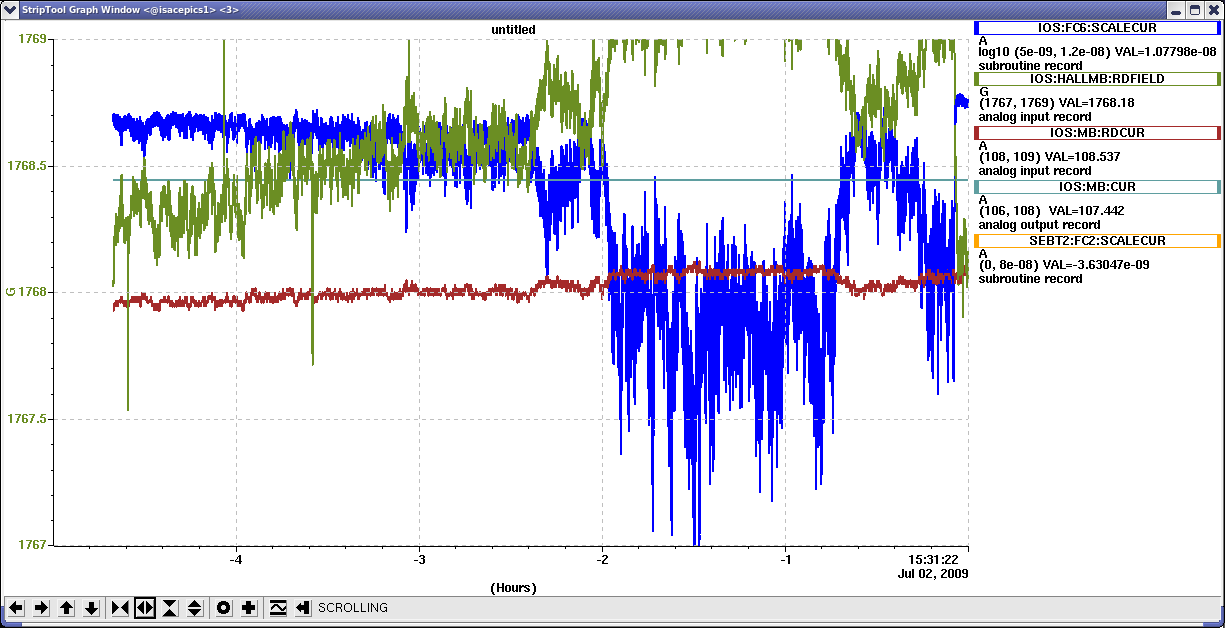 |
| Attachment 3: grab.C15389.png
|
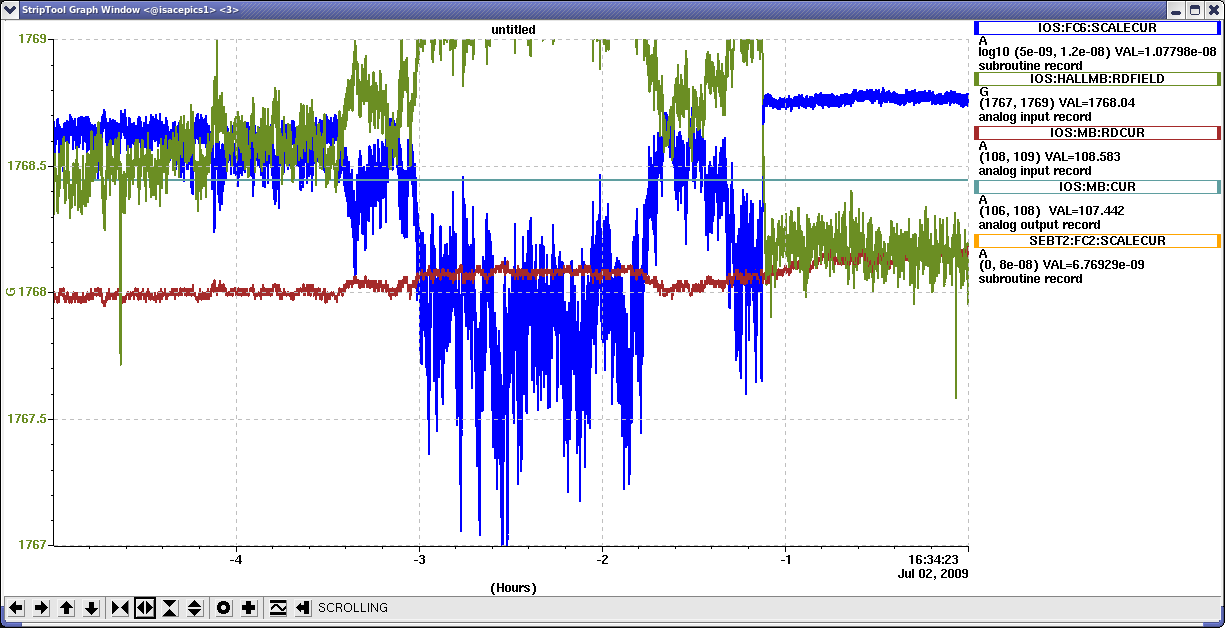 |
|
72
|
Wed Jul 15 09:20:26 2009 |
Damien Gallop | | | Supernanogan development in progress |
Proposed run plan for this time:
- Document TIGRESS tune.
- 18O4+ emittance scan.
- Mass scan A/q = 0 to 25.
- Repeat 18On+ emittance scans at present RF frequency.
- 16On+ emittance scans at present frequency.
- Plot 16On+ & 18On+ emittance on one graph.
- If indicated, then do 17On+ background study.
- Open 17O gas bottle to system.
- 17On+ resonance survey based on 18On+ results.
- 17On+ emittance scans.
- Add 17On+ emittance values to graph.
|
|
13
|
Wed Jun 10 11:22:59 2009 |
Damien Gallop | Routine | General | Supernanogan development mass scans |
Main event this morning so far: mass scans and post-scan analysis using Gabe's tools. We have a pretty good recipe now. Tight scan to mass 20 in progress. Later... good scan. Geoff and I did a dry run of our presentations for Friday morning. We used the Auditorium computers, etc. After some small teething pains, everything went well, including a cold start-up of the source. The 17O3+ emittance scan was taken quickly. Pretty good outcome anyway. The mass scan shows nice peaks at several known points: 1H+, 2H2, 4He, 7Li, 12C, 14N, 16O, 19F and 20Ne. Gabe's Calibrate tool returns values for the two constants that are pretty close to what is there now: -1 and 0.0419 calculated versus 0 and 0.0418 actual. |
| Attachment 1: grab.t27875.png
|
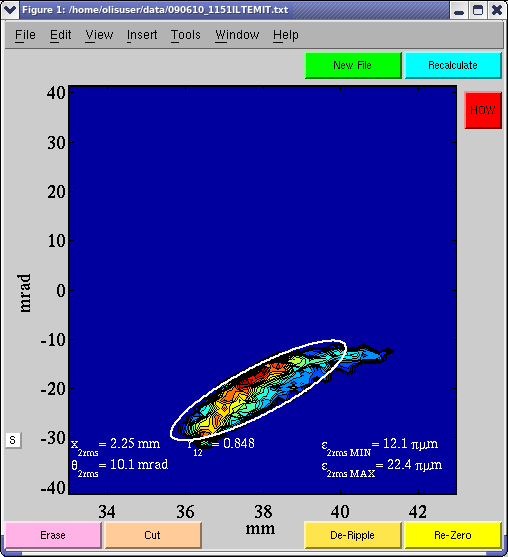 |
| Attachment 2: grab.R27900.png
|
 |
| Attachment 3: grab.H27444.png
|
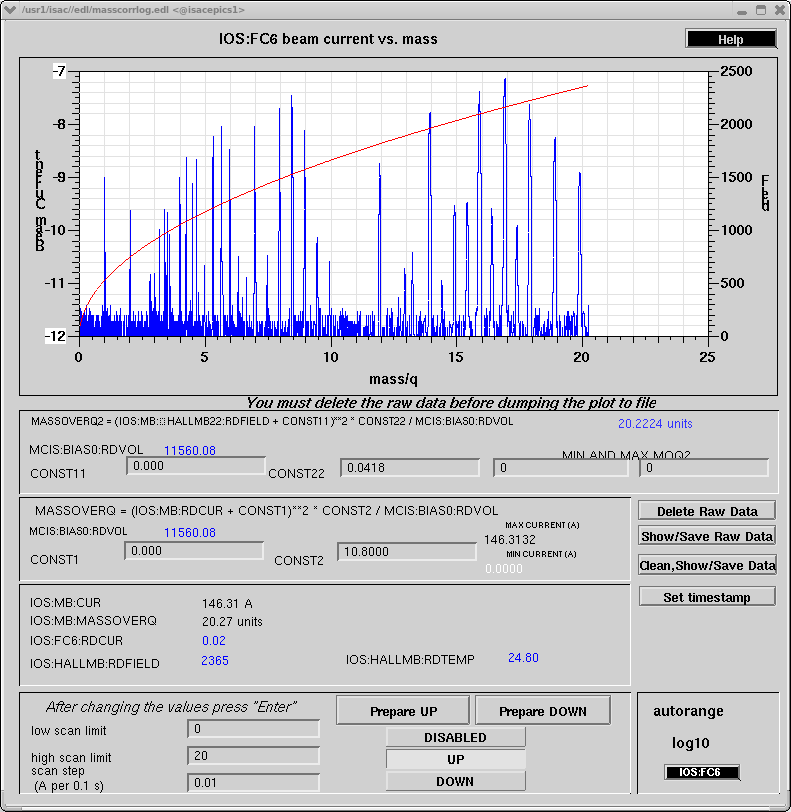 |
|
51
|
Wed Jul 8 11:52:54 2009 |
Damien Gallop | Routine | General | Supernanogan development run plan for the remainder of this set |
* 18On+ emittance scans at present ion source settings: complete today.
* 18On+ frequency measurements: Thursday.
* 17O source gas: open end of Thursday.
* 17On+ frequency survey: Friday.
* 17On+ emittance scans at idealized source settings: Monday.
* Development completion: Tuesday.
* 18O4+ setup for beam schedule: Wednesday. |
|
223
|
Tue Feb 2 10:06:41 2010 |
Damien Gallop | | | Supernanogan development wind-up |
We ran 32S5+ overnight. Keerthi has been working with the new surface source oven for the last couple of weeks. His results to come. Meanwhile, here are a stripchart of overnight beam plus a few panels after my tweaking. Slits are at 5mm position.
Observations:
- The heater responds smoothly in 0.1A steps.
- There is an optimal heater setting; more is not necesaarily more.
- As always, there are several RF resonances within a range.
- Higher resonance produces more beam but less stable.
- Lower resonance produces less beam but more stable.
- Optimal heater loading technique and current setting will require further study.
Save: 100202_1000.snapiosfc6
Last stripchart is FC6 starting a couple of minutes before shutting off the heater.
Power down everything around 17:30, and turn off IOS turbos. I have left IOS:IV0 open to ensure the intermediate section gets vented before the cart is removed. I am leaving the MCIS turbos on for now,. to continue pumpimg residual sulphur. |
| Attachment 1: grab.U23715.png
|
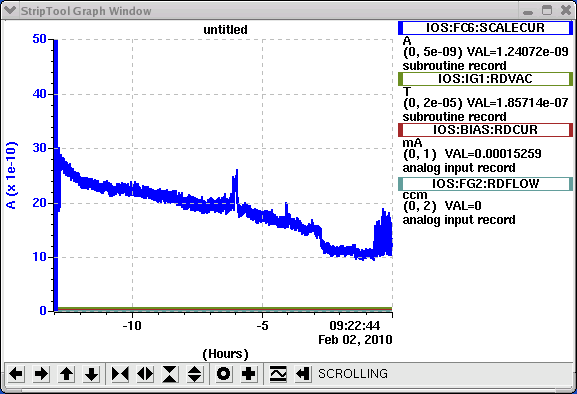 |
| Attachment 2: grab.u23727.png
|
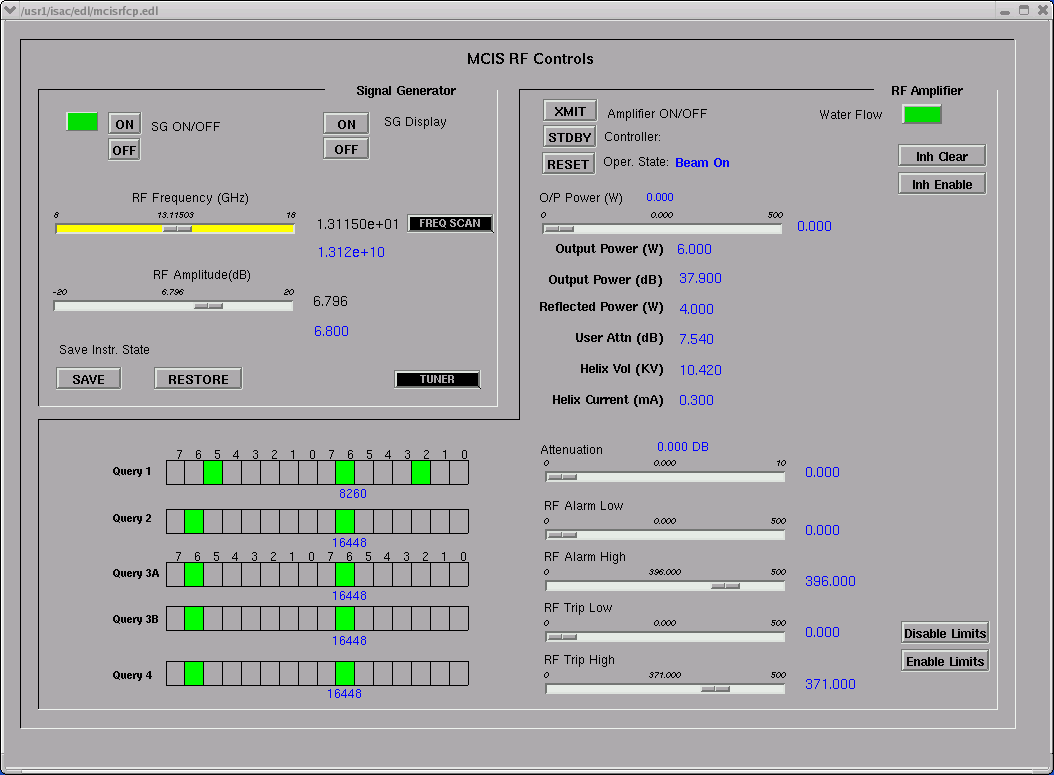 |
| Attachment 3: grab.s23853.png
|
 |
| Attachment 4: grab.w23857.png
|
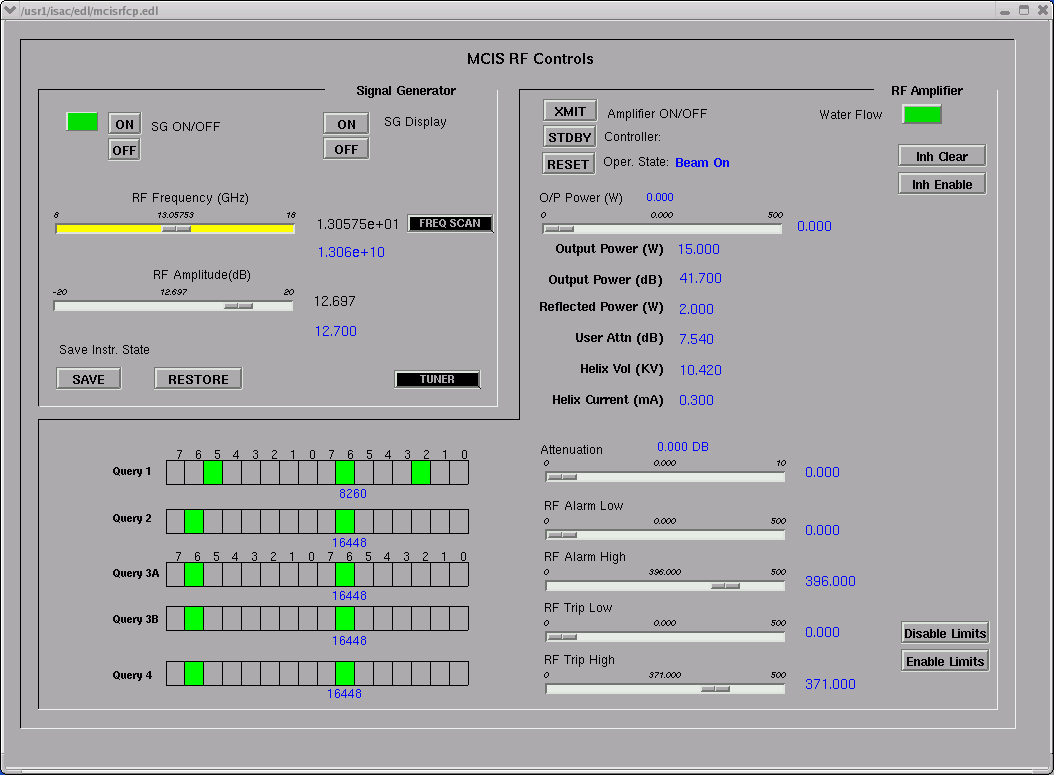 |
| Attachment 5: grab.b23861.png
|
 |
| Attachment 6: grab.a24018.png
|
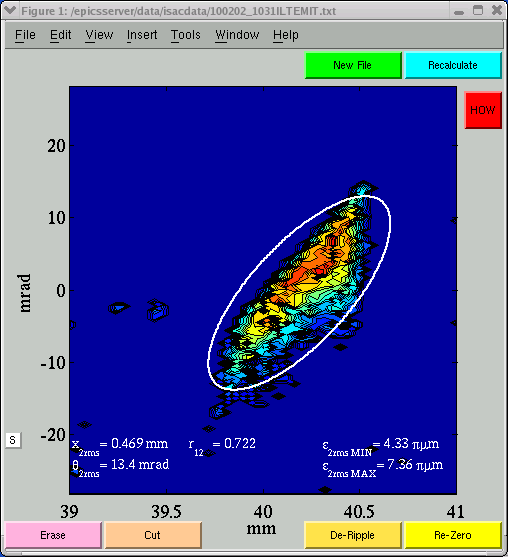 |
| Attachment 7: grab.x24022.png
|
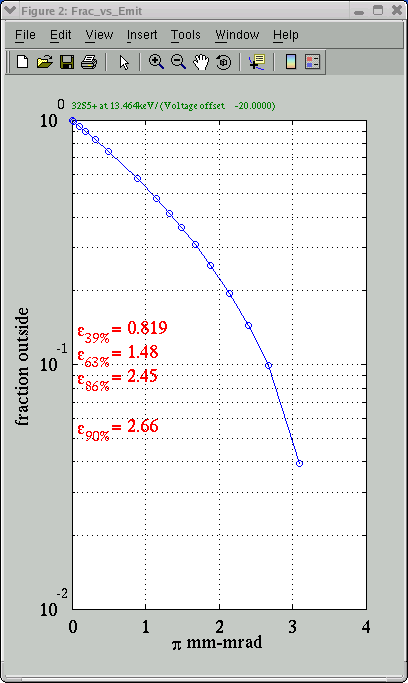 |
| Attachment 8: grab.U24026.png
|
 |
| Attachment 9: grab.v24981.png
|
 |
|
138
|
Tue Sep 15 19:46:21 2009 |
Keerthi | Routine | General | Supernanogan emittance scans |
090915_1915ILTEMIT.txt = 17O +3, 4.4uA new tune, scanner offset +10V, scanner scale 100nA , 100x50 matrix
090915_1929ILTEMIT.txt = same as above with 200x100 matrix
090915_1949ILTEMIT.txt = after tune tweaking (not optimal; for reference only) |
| Attachment 1: grab.w23925.png
|
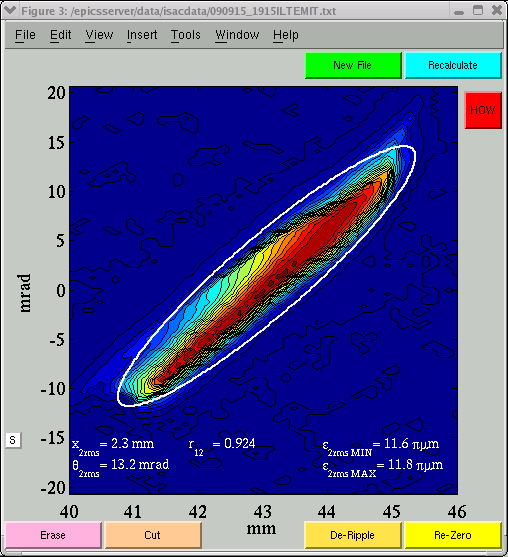 |
| Attachment 2: grab.L23930.png
|
 |
| Attachment 3: grab.J23942.png
|
 |
| Attachment 4: grab.K23948.png
|
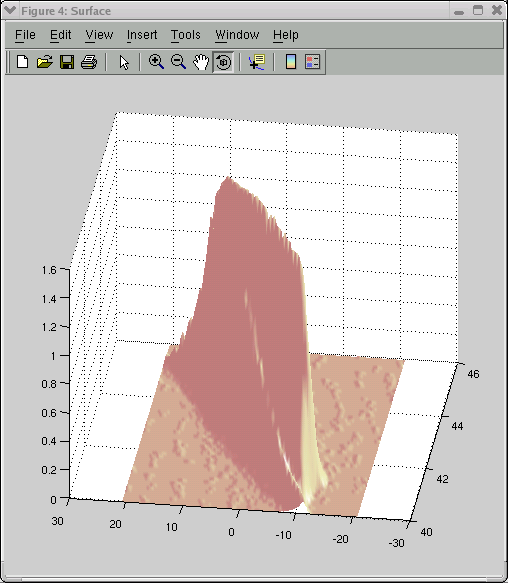 |
| Attachment 5: grab.N23902.png
|
 |
| Attachment 6: grab.f23908.png
|
 |
| Attachment 7: grab.C23914.png
|
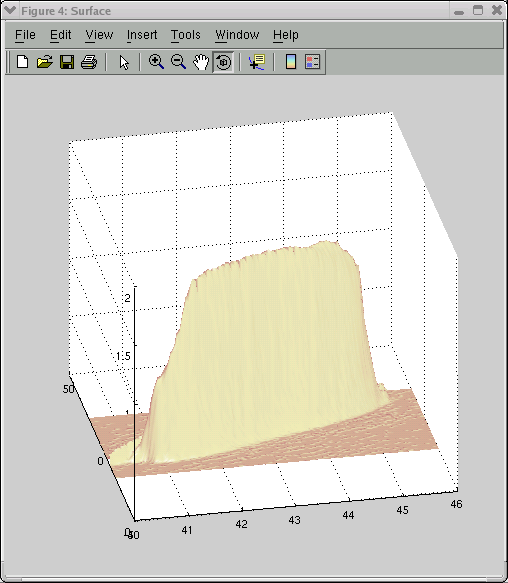 |
| Attachment 8: grab.v23919.png
|
 |
| Attachment 9: grab.y24035.png
|
 |
|
99
|
Fri Jul 17 09:33:09 2009 |
Damien Gallop | | | Supernanogan epilogue |
There are the last couple of hours of Supernanogan Development for this set. Our run plan included 17On+ studies. Time will not permit it this time around. Also, the emittance numbers of 16O and 18O are not distinctive enough as they stand to warrant studies of the in-between mass. Keerthi will run the emittance data files through his software during post-analysis, and we'll develop our next run plan based on his conclusions.
This morning I will redo a couple of emittance scans that were not optimal yesterday. We'll start with an 18O4+ emittance check, then 18O8+, where, though I don't expect an emittance scan, I do expect to see beam. A vacuum trip on Wednesday evening probably compromised source vacuum and therefore the ability to generate the higher charge states. Here we go.
18O4+ emittance checks well. |
| Attachment 1: grab.a24906.png
|
 |
| Attachment 2: grab.Q24916.png
|
 |
|
222
|
Fri Jan 15 15:30:02 2010 |
keerthi | | | Supernanogan oven start up |
Voltage Current MCIC:IG1
0 0 7.35e-8
0.3 0.2 "
1.6 0.4 9.1 e-8
1.6 0.4 7.79e-8 (5min later)
3.3 0.6 8.61e-8
3.3 0.6 8.98e-8 (5min later)
3.3 0.6 9.42e-8(10min later) 14.:36
3.3 0.58 7.89e-8 15:28pm
5.8(9.62RB) 0.8(0.48RB) 1.51e-7 15:30pm
5.8 (9.62RB 0.78(0.47RB) 8.17e-8 16:30pm
8.5V(14.15RB) 1.0(0.60RB) 9.5e-8) 16.33pm
8.5V(14.15RB) 0.97)0.58RB) 8.52e-8 16:45pm
11.6V(19.47RB) 1.20(0.72RB) 1.08e-7 16:47pm
15.2V(25.27RB) 1.4(0.83RB) 1.34e-7 16:53
20.0V(33.02RB) 1.6A(0.96RB) 1.6e-7 17:00
18.4V(30.52RB) 1.64A(0.98RB) 8.6e-8 17:30
21.6V(35.92VRB) 1.8A(1.07RB) 9.42e-8 17:40
25.7V(42.73RB) 2.0A(1.21RB) 1.43e-7 17:50
23.6V(23.14RB) 2.02A(1.21RB) 7.7e-8 20:20
Oven is off 7.62e-8 20:22
|
|
16
|
Thu Jun 11 12:10:22 2009 |
Damien Gallop | Routine | General | Supernanogan status |
Pumping went well overnight. TP3 turned on around noon. Issues with Kepco communications. |